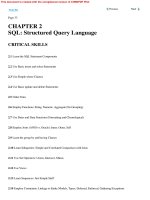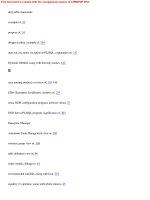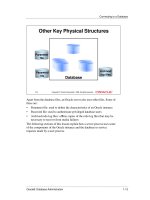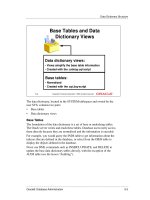Oracle 8 Database Administration volume 2 instruction guide phần 1 pot
Bạn đang xem bản rút gọn của tài liệu. Xem và tải ngay bản đầy đủ của tài liệu tại đây (86.7 KB, 34 trang )
Oracle8: Database Administration
Volume 2 • Instructor Guide
30020GC10
Production 1.0
March 1998
M06292
Copyright Oracle Corporation, 1998. All rights reserved.
This documentation contains proprietary information of Oracle Corporation. It is
provided under a license agreement containing restrictions on use and disclosure
and is also protected by copyright law. Reverse engineering of the software is
prohibited. If this documentation is delivered to a U.S. Government Agency of the
Department of Defense, then it is delivered with Restricted Rights and the
following legend is applicable:
Restricted Rights Legend
Use, duplication or disclosure by the Government is subject to restrictions for
commercial computer software and shall be deemed to be Restricted Rights
software under Federal law, as set forth in subparagraph (c) (1) (ii) of DFARS
252.227-7013, Rights in Technical Data and Computer Software (October 1988).
This material or any portion of it may not be copied in any form or by any means
without the express prior written permission of the Worldwide Education Services
group of Oracle Corporation. Any other copying is a violation of copyright law and
may result in civil and/or criminal penalties.
If this documentation is delivered to a U.S. Government Agency not within the
Department of Defense, then it is delivered with “Restricted Right,” as defined in
FAR 52.227-14, Rights in Data-General, including Alternate III (June 1987).
The information in this document is subject to change without notice. If you find
any problems in the documentation, please report them in writing to Education
Products, Oracle Corporation, 500 Oracle Parkway, Box 659806, Redwood
Shores, CA 94065. Oracle Corporation does not warrant that this document is
error-free.
SQL*Loader, SQL*Net, SQL*Plus, Net8, Oracle Call Interface, Oracle7,
Oracle8, Developer/2000, Developer/2000 Forms, Designer/2000, Oracle
Enterprise Manager, Oracle Parallel Server, Oracle Server Manager, PL/
SQL, Pro*C, Pro*C/C++, and Trusted Oracle are trademarks or registered
trademarks of Oracle Corporation.
All other products or company names are used for identification purposes only,
and may be trademarks of their respective owners.
Authors
Ulrike Schwinn
Vijayanandan Venkatachalam
Technical Contributors
and Reviewers
David Austin
Ben van Balen
Gerry Batista
Doug Bridges
Sandra Cheevers
Bruce Ernst
Joel Goodman
Scott Gossett
Lex de Haan
Tony Holbrook
Heike Hundt
Christine Jeal
Dominique Jeunot
Thomas Kerepes
Steven King
Pierre Labrousse
Dean Margolese
Jean-Marie Misztela
Tigger Newman
Howard Ostrow
Hans Proetzl
Gary Purcell
Shankar Raman
Donalyn Selinsky
Roger Simon
Jim Spiller
Ramonito Te
Sabine Teuber
Jean-Francois Verrier
Norbert Wittje
Publishers
Stephanie Jones
Kelly Lee
Renee Voss
Oracle8: Database Administration iii
.
Contents
Preface
Profile xii
Related Publications xiii
Typographic Conventions xiv
Curriculum Map
Oracle8 Database Administrator Curriculum xviii
Advanced DBA Curriculum xix
Introduction
Course Objectives I-3
Oracle8 Enterprise Edition I-4
Database Administrator Tasks I-5
Course Schedule I-6
Lesson 1: Oracle Architectural Components
Objectives 1-3
Overview 1-4
Connecting to a Database 1-6
Running a Query 1-14
Running a DML Statement 1-19
COMMIT Processing 1-25
Summary 1-27
Lesson 2: Using Administration Tools
Objectives 2-3
Overview 2-4
Using the Server Manager 2-5
Oracle Enterprise Manager 2-9
OEM Components 2-11
Using Oracle Enterprise Manager 2-19
Summary 2-24
Lesson 3: Managing an Oracle Instance
Objectives 3-3
Overview 3-4
Validating Privileged Users 3-5
Creating a Parameter File 3-14
Stages in Startup and Shutdown 3-19
Starting Up 3-22
Shutting Down 3-25
Getting and Setting Parameter Values 3-30
Managing Sessions 3-36
Trace Files and the ALERT File 3-40
Summary 3-43
iv Oracle8: Database Administration
.
Contents
Lesson 4: Creating a Database
Objectives 4-3
Overview 4-4
Preparing the Operating System 4-5
Creating a Database 4-12
Lesson 5: Creating Data Dictionary Views and Standard Packages
Objectives 5-3
Data Dictionary Structure 5-4
Constructing the Data Dictionary 5-11
Using Administrative Scripts 5-13
Administering Stored Procedures and Packages 5-15
Obtaining Information 5-23
Troubleshooting 5-26
Summary 5-27
Lesson 6: Maintaining the Control File
Objectives 6-3
Using the Control File 6-4
The Contents of the Control File 6-5
Obtaining Information About the Control File 6-7
Multiplexing the Control File 6-9
Summary 6-10
Lesson 7: Maintaining Redo Log Files
Objectives 7-3
Overview 7-4
Using Online Redo Files 7-5
LGWR, Log Switches, and Checkpoints 7-7
Archiving Redo Log Files 7-9
Obtaining Log and Archive Information 7-11
Controlling Log Switches and Checkpoints 7-17
Multiplexing and Maintaining Members and Groups 7-19
Relocating Online Redo Log Files 7-22
Dropping Online Redo Log Groups and Members 7-23
Clearing Online Redo Log Files 7-27
Planning Online Redo Logs 7-28
Troubleshooting 7-30
Summary 7-31
Oracle8: Database Administration v
.
Contents
Lesson 8: Managing Tablespaces and Data Files
Objectives 8-3
Overview 8-4
Logical Database Structure 8-5
Creating Tablespaces 8-8
Changing the Size of Tablespaces 8-16
Changing the Size of Data Files 8-18
Changing the Storage Settings 8-21
Taking Tablespaces Offline or Online 8-22
Moving Data Files 8-24
Read-Only Tablespaces 8-27
Dropping Tablespaces 8-30
Data Dictionary Information 8-32
Considerations in Creating Tablespaces 8-37
Lesson 9: Storage Structure and Relationships
Objectives 9-3
Overview 9-4
Types of Segments 9-5
Using Block Space Utilization Parameters 9-16
Obtaining Information About Storage Structures 9-21
Planning the Location of Segments 9-25
Summary 9-27
Lesson 10: Managing Rollback Segments
Objectives 10-3
Overview 10-4
Rollback Segments 10-5
Using Rollback Segments with Transactions 10-8
Planning Rollback Segments 10-13
Creating Rollback Segments 10-15
Maintaining Rollback Segments 10-21
Obtaining Rollback Segment Information 10-26
Troubleshooting Rollback Segment Problems 10-32
Summary 10-39
Lesson 11: Managing Temporary Segments
Objectives 11-3
Overview 11-4
Types of Temporary Segments 11-6
Allocating Space for Temporary Segments 11-9
Obtaining Temporary Segment Information 11-11
Summary 11-14
vi Oracle8: Database Administration
.
Contents
Lesson 12: Managing Tables
Objectives 12-3
Overview 12-4
Oracle Data Types 12-7
Creating a Table 12-16
Controlling Space Used by Tables 12-24
Retrieving Table Information 12-42
Summary 12-47
Lesson 13: Managing Indexes
Objectives 13-3
Types of Indexes 13-4
Creating Indexes 13-12
Reorganizing Indexes 13-20
Dropping Indexes 13-26
Obtaining Index Information 13-28
Summary 13-30
Lesson 14: Maintaining Data Integrity
Objectives 14-3
Overview 14-4
Integrity Constraints and Triggers 14-6
Implementing Constraints and Triggers 14-16
Maintaining Constraints and Triggers 14-20
Getting Constraint and Trigger Information 14-31
Summary 14-36
Lesson 15: Using Clusters and Index-Organized Tables
Objectives 15-3
Overview 15-4
Clusters 15-5
Creating Clusters 15-9
Maintaining Clusters 15-17
Retrieving Information About Clusters 15-21
Index-Organized Tables 15-24
Using Index-Organized Tables 15-26
Retrieving Information About Index-Organized Tables 15-31
Summary 15-32
Lesson 16: Loading and Reorganizing Data
Objectives 16-3
Overview 16-4
Loading Data Using Direct-Load Insert 16-6
Loading Data Using SQL*Loader 16-9
Reorganizing Data Using Export and Import 16-29
Summary 16-48
Oracle8: Database Administration vii
.
Contents
Lesson 17: Managing Users
Objectives 17-3
Overview 17-4
Creating New Database Users 17-7
Altering and Dropping Database Users 17-14
Dropping Users 17-18
Monitoring Information About Users 17-19
Summary 17-21
Lesson 18: Managing Profiles
Objectives 18-3
Overview 18-4
Controlling Usage of Resources 18-6
Altering and Dropping a Profile 18-14
Viewing Resource Limits 18-18
Administering Passwords 18-20
Viewing Password Information 18-27
Summary 18-29
Lesson 19: Managing Privileges
Objectives 19-3
Overview 19-4
System Privileges 19-5
Granting System Privileges 19-8
Password File Authentication 19-10
Displaying System Privileges 19-13
Revoking System Privileges 19-17
Object Privileges 19-20
Granting Object Privileges 19-21
Displaying Object Privileges 19-23
Revoking Object Privileges 19-25
Summary 19-29
Lesson 20: Managing Roles
Objectives 20-3
Overview 20-4
Creating and Modifying Roles 20-7
Assigning Roles 20-13
Controlling Availability of Roles 20-15
Displaying Role Information 20-27
Summary 20-28
viii Oracle8: Database Administration
.
Contents
Lesson 21: Auditing
Objectives 21-3
Overview 21-4
Using Database Auditing 21-7
Viewing Auditing Results 21-18
Auditing Guidelines 21-20
Summary 21-22
Lesson 22: Using National Language Support
Objectives 22-3
Overview 22-4
Choosing a Database and a National Character Set 22-6
Specifying Language-Dependent Behavior 22-12
NLS Parameters and SQL-Functions 22-20
NLS Parameters in SQL-Functions 22-22
Importing and Loading Data Using NLS 22-26
Obtaining Information About NLS Settings 22-27
Summary 22-32
Appendix A: Practices
Environment A-2
Exercise 1—Oracle Architectural Components A-3
Lab 2—Using Administration Tools A-5
Lab 3—Managing an Oracle Instance A-6
Lab 4—Creating a Database A-8
Lab 5—Creating Data Dictionary Views and Standard Packages A-9
Lab 6—Maintaining the Control File A-10
Lab 7—Maintaining Redo Log Files A-11
Lab 8—Managing Tablespaces and Data Files A-12
Lab 9—Storage Structure and Relationships A-13
Lab 10—Managing Rollback Segments A-14
Lab 11—Managing Temporary Segments A-15
Lab 12—Managing Tables A-16
Lab 13—Managing Indexes A-18
Lab 14—Maintaining Data Integrity A-20
Lab 15—Using Clusters and Index-Organized Tables A-22
Lab 16—Loading and Reorganizing Data A-23
Lab 17—Managing Users A-25
Lab 18—Managing Profiles A-26
Lab 19—Managing Privileges A-27
Lab 20—Managing Roles A-28
Lab 21—Auditing A-29
Lab 22—Using National Language Support A-30
Oracle8: Database Administration ix
.
Contents
Appendix B: Hints
Exercise 1—Oracle Architectural Components B-2
Lab 2—Using Administration Tools B-3
Lab 3—Managing an Oracle Instance B-4
Lab 4—Creating a Database B-7
Lab 5—Creating Data Dictionary Views and Standard Packages B-9
Lab 6—Maintaining the Control File B-10
Lab 7—Maintaining Redo Log Files B-11
Lab 8—Managing Tablespaces and Data Files B-13
Lab 9—Storage Structure and Relationships B-15
Lab 10—Managing Rollback Segments B-17
Lab 11—Managing Temporary Segments B-19
Lab 12—Managing Tables B-20
Lab 13—Managing Indexes B-22
Lab 14—Maintaining Data Integrity B-24
Lab 15—Using Clusters and Index-Organized Tables B-26
Lab 16—Loading and Reorganizing Data B-28
Lab 17—Managing Users B-30
Lab 18—Managing Profiles B-31
Lab 19—Managing Privileges B-33
Lab 20—Managing Roles B-34
Lab 21—Auditing B-35
Lab 22—Using National Language Support B-36
Appendix C: Server Manager Solutions
Exercise 1—Oracle Architectural Components C-2
Lab 2—Using Administration Tools C-4
Lab 3—Managing an Oracle Instance C-8
Lab 4—Creating a Database C-16
Lab 5—Creating Data Dictionary Views and Standard Packages C-20
Lab 6—Maintaining the Control File C-25
Lab 7—Maintaining Redo Log Files C-29
Lab 8—Managing Tablespaces and Data Files C-35
Lab 9—Storage Structure and Relationships C-40
Lab 10—Managing Rollback Segments C-47
Lab 11—Managing Temporary Segments C-56
Lab 12—Managing Tables C-60
Lab 13—Managing Indexes C-70
Lab 14—Maintaining Data Integrity C-78
Lab 15—Using Clusters and Index-Organized Tables C-87
Lab 16—Loading and Reorganizing Data C-92
Lab 17—Managing Users C-102
Lab 18—Managing Profiles C-105
Lab 19—Managing Privileges C-112
Lab 20—Managing Roles C-117
x Oracle8: Database Administration
.
Contents
Lab 21—Auditing C-120
Lab 22—Using National Language Support C-121
Appendix D: Oracle Enterprise Manager Solutions
Exercise 1—Oracle Architectural Components D-3
Lab 2—Using Administration Tools D-5
Lab 3—Managing an Oracle Instance D-9
Lab 4—Creating a Database D-18
Lab 5—Creating Data Dictionary Views and Standard Packages D-21
Lab 6—Maintaining the Control File D-25
Lab 7—Maintaining Redo Log Files D-28
Lab 8—Managing Tablespaces and Data Files D-34
Lab 9—Storage Structure and Relationships D-38
Lab 10—Managing Rollback Segments D-46
Lab 11—Managing Temporary Segments D-55
Lab 12—Managing Tables D-59
Lab 13—Managing Indexes D-68
Lab 14—Maintaining Data Integrity D-76
Lab 15—Using Clusters and Index-Organized Tables D-85
Lab 16—Loading and Reorganizing Data D-90
Lab 17—Managing Users D-100
Lab 18—Managing Profiles D-103
Lab 19—Managing Privileges D-110
Lab 20—Managing Roles D-115
Lab 21—Auditing D-118
Lab 22—Using National Language Support D-119
Appendix E: Certification Test: Sample Questions
Oracle Certified Professional (OCP) Program:
Oracle Certified Database Administrator Track E-2
Oracle Database Administration: Sample Test E-3
Oracle Backup and Recovery: Sample Test E-5
Answers E-8
Registering for an OCP Test E-9
13
Managing Indexes
13-2 Oracle8: Database Administration
.
Lesson 13: Managing Indexes
Instructor Note
Topic Timing
Lecture 30 minutes
Practice 45 minutes
Total 75 minutes
Oracle8: Database Administration 13-3
.
Objectives
Objectives
13-2
Copyright Oracle Corporation, 1998. All rights reserved.
Objectives
• Listing the different types of indexes
and their uses
• Creating B-tree and Bitmap indexes
• Reorganizing indexes
• Dropping indexes
• Getting index information from the data
dictionary
13-4 Oracle8: Database Administration
.
Lesson 13: Managing Indexes
Types of Indexes
An index is a tree structure that allows direct access to a row in a table.
Indexes can be classified based on their logical design or on their physical
implementation. The logical classification groups indexes from an
application perspective, while the physical classification is derived from the
way the indexes are stored.
Single Column and Concatenated Indexes
A single column index has only one column in the index key
—for example,
an index on the employee number column of an employee table.
A concatenated index, also known as a composite index, is created on
multiple columns in a table. Columns in a concatenated index do not need to
be in the same order as the columns in the table, nor do they need to be
adjacent
—for example, an index on the department and job columns of an
employee table.
The maximum number of columns in a composite key index is 32. However,
the combined size of all the columns cannot exceed roughly one-third of the
data block size.
13-3
Copyright Oracle Corporation, 1998. All rights reserved.
Classification of Indexes
Logical
• Single column or concatenated
• Unique or nonunique
Physical
• Partitioned or nonpartitioned
• B-tree or bitmap
– Normal or reverse key (B-tree only)
Oracle8: Database Administration 13-5
.
Types of Indexes
Unique and Nonunique Indexes
A unique index guarantees that no two rows of a table have duplicate values
in the column that defines the index. An index key in a unique index can
only point to one row in the table.
In a nonunique index, a single key can have multiple rows associated with it.
Partitioned and Nonpartitioned Indexes
Partitioned indexes are used for large tables to store index entries
corresponding to an index in several segments. Partitioning allows an index
to be spread across many tablespaces, decreasing contention for index
lookup and increasing manageability. Partitioned indexes are often used with
partitioned tables to improve scalability and manageability. An index
partition can be created for each table partition.
This lesson discusses the creation and maintenance of nonpartitioned B-tree
and bitmap indexes.
Instructor Note
Do not discuss partitioning. Partitioned indexes will be covered in a different
course.
13-6 Oracle8: Database Administration
.
Lesson 13: Managing Indexes
Although all the indexes use a B-tree structure, the term B-tree index is
usually associated with an index that stores a list of ROWIDS for each key.
Structure of a B-Tree Index
At the top of the index is the root, which contains entries that point to the
next level in the index. At the next level are branch blocks, which in turn
point to blocks at the next level in the index. At the lowest level are the leaf
nodes, which contain the index entries that point to rows in the table. The
leaf blocks are doubly linked to facilitate scanning the index in an ascending
as well as descending order of key values.
Format of Index Leaf Entries
An index entry is made up of the following components:
• An entry header, which stores number of columns and locking
information
• Key column length-value pairs, which define the size of a column in the
key followed by the value for the column (The number of such pairs is a
maximum of the number of columns in the index.)
• ROWID of a row, which contains the key values
13-4
Copyright Oracle Corporation, 1998. All rights reserved.
B-Tree Index
Index entry header
Key column length
Key column value
ROWID
Root
Branch
Leaf
Index entry
Oracle8: Database Administration 13-7
.
Types of Indexes
Index Leaf Entry Characteristics
In a B-tree index on a nonpartitioned table:
• Key values are repeated if there are multiple rows that have the same key
value.
• There is no index entry corresponding to a row that has all key columns
that are NULL.
• Restricted ROWID is used to point to the rows of the table, since all rows
belong to the same segment.
Effect of DML Operations on an Index
The Oracle server maintains all the indexes when DML operations are
carried out on the table. Here is an explanation of the effect of a DML
command on an index:
• Insert operations result in the insertion of an index entry in the
appropriate block.
• Deleting a row results only in a logical deletion of the index entry. The
space used by the deleted row is not available for new entries until all the
entries in the block are deleted.
• Updates to the key columns result in a logical delete and an insert to the
index. The PCTFREE setting has no effect on the index except at the
time of creation. A new entry may be added to an index block even if it
has less space than that specified by PCTFREE.
Instructor Note
You may want to inform the interested students of the following:
• Oracle does not use binary tree indexes, but a balanced tree structure
• The third-bulleted point under “Index Leaf Entry Characteristics” is only
true for global indexes on nonpartitioned tables.
13-8 Oracle8: Database Administration
.
Lesson 13: Managing Indexes
In contrast to a regular B-tree index, a reverse key index reverses the bytes of
each column indexed (except the ROWID) while keeping the column order.
When inserting records on an ascending key, such as a system-generated
employee number, I/O bottlenecks can occur on the index because all index
updates occur at the same place in the index tree. Reverse key indexes
spread the distribution of index updates across the index tree by reversing
the data value of the index key.
For example, on insert of employee number 7698 in the table, a key value of
8967 is stored in the index. As the next employee number 7782 is entered, an
index entry is made for 2877, thereby spreading the work load across
multiple index blocks.
Such an arrangement can be especially useful in avoiding performance
degradation in indexes in an Oracle Parallel Server environment.
Reverse key indexes are useful only for queries that contain equality
predicates. Because lexically adjacent keys are not stored next to each other
in a reverse key index, range searches cannot be performed using such an
index.
13-5
Copyright Oracle Corporation, 1998. All rights reserved.
KEY ROWID
EMPNO (BLOCK# ROW# FILE#)
1257 0000000F.0002.0001
2877 0000000F.0006.0001
4567 0000000F.0004.0001
6657 0000000F.0003.0001
8967 0000000F.0005.0001
9637 0000000F.0001.0001
9947 0000000F.0000.0001
Reverse Key Index
Index on EMP (EMPNO)
EMP table
EMPNO ENAME JOB
7499 ALLEN SALESMAN
7369 SMITH CLERK
7521 WARD SALESMAN
7566 JONES MANAGER
7654 MARTIN SALESMAN
7698 BLAKE MANAGER
7782 CLARK MANAGER
Oracle8: Database Administration 13-9
.
Types of Indexes
Bitmap indexes are more advantageous than B-tree indexes in certain
situations:
• When a table has millions of rows and the key columns have low
cardinality
—that is, there are very few distinct values for the column. For
example, bitmap indexes may be preferable to B-tree indexes for the
gender and marital status columns of a table containing passport records.
• When queries often use a combination of multiple WHERE conditions
involving the OR operator.
• When there is read-only or low update activity on the key columns.
Structure of a Bitmap Index
A bitmap index is also organized as a B-tree, but the leaf node stores a
bitmap for each key value instead of a list of ROWIDS. Each bit in the
bitmap corresponds to a possible ROWID, and if the bit is set, it means that
the row with the corresponding ROWID contains the key value.
13-6
Copyright Oracle Corporation, 1998. All rights reserved.
Bitmap Index
<Blue, 10.0.3, 12.8.3, 1000100100010010100>
<Green, 10.0.3, 12.8.3, 0001010000100100000>
<Red, 10.0.3, 12.8.3, 0100000011000001001>
<Yellow, 10.0.3, 12.8.3, 0010001000001000010>
key
start
ROWID
end
ROWID bitmap
Table
Index
Block 10
Block 11
Block 12
File 3
13-10 Oracle8: Database Administration
.
Lesson 13: Managing Indexes
As shown in the diagram, the leaf node of a bitmap index contains the
following:
•Anentry header, containing number of columns and lock information.
• Key values consisting of length and value pairs for each key column (In
the example, the key consists of only one column, and the first entry has
a key value of Blue.)
• Start ROWID, which in the example contains a file number 3, a block
number 10, and a row number 0
• End ROWID, which in the example includes a block number 12 and a
row number 8
•Abitmap segment consisting of a string of bits (The bit is set when the
corresponding row contains the key value and is unset when the row
does not contain the key value. The Oracle server uses a patented
compression technique to store bitmap segments.)
The start ROWID is the ROWID of the first row pointed to by the bitmap
segment of the bitmap
—that is, the first bit of the bitmap corresponds to that
ROWID, the second bit of the bitmap corresponds to the next row in the
block, and the end ROWID is a pointer to the last row in the table covered by
the bitmap segment. Bitmap indexes use restricted ROWIDs.
Using a Bitmap Index
The B-tree is used to locate the leaf nodes that contain bitmap segments for a
given value of the key. Start ROWID and the bitmap segments are used to
locate the rows that contain the key value.
When changes are made to the key column in the table, bitmaps must be
modified. This results in locking of the relevant bitmap segments. Because
locks are acquired on the whole bitmap segment, a row that is covered by the
bitmap cannot be updated by other transactions until the first transaction
ends.
Oracle8: Database Administration 13-11
.
Types of Indexes
The table in the slide compares B-tree indexes to bitmap indexes.
Bitmap indexes are more compact than B-tree indexes when used with
low-cardinality columns.
Updates to key columns in a bitmap index are more expensive because
bitmaps use bitmap-segment-level locking, whereas in a B-tree index, locks
are on entries corresponding to individual rows of the table.
Bitmap indexes can be used to perform operations such as Bitmap OR
—that
is, the Oracle server can use two bitmap segments to perform a bitwise OR
and get a resulting bitmap. This allows efficient use of bitmaps in queries
that use the OR predicate.
In summary, B-tree indexes may be more suitable in an OLTP environment
for indexing dynamic tables, whereas bitmap indexes may be useful in DSS
environments where complex queries are used on large, static tables.
13-7
Copyright Oracle Corporation, 1998. All rights reserved.
Comparing B-Tree and
Bitmap Indexes
B-tree
Suitable for high-cardinality
columns
Updates on keys relatively
inexpensive
Inefficient for queries
using OR predicates
Useful for OLTP
Bitmap
Suitable for low-cardinality
columns
Updates to key columns very
expensive
Efficient for queries
using OR predicates
Useful for DSS
13-12 Oracle8: Database Administration
.
Lesson 13: Managing Indexes
Creating Indexes
An index can be created either in the account of the user who owns the table
or in a different account, although it is generally created in the same account
as the table.
Syntax
Use the following command to create a B-tree index:
CREATE [ UNIQUE ]INDEX [schema.] index
ON [schema.] table
(column [
ASC | DESC ] [ , column [ASC | DESC ] ] )
[ TABLESPACE tablespace ]
[ PCTFREE integer ]
[ INITRANS integer ]
[ MAXTRANS integer ]
[ storage-clause ]
[ LOGGING| NOLOGGING ]
[ NOSORT ]
13-8
Copyright Oracle Corporation, 1998. All rights reserved.
Creating Normal B-Tree Indexes
CREATE INDEX scott.emp_lname_idx
ON scott.employees(last_name)
PCTFREE 30
STORAGE(INITIAL 200K NEXT 200K
PCTINCREASE 0 MAXEXTENTS 50)
TABLESPACE indx01;
Oracle8: Database Administration 13-13
.
Creating Indexes
where: UNIQUE is used to specify a unique index
(Nonunique is the default.)
schema is the owner of the index/table
index is the name of the index
table is the name of the table
column is the name of the column
ASC/ DESC isprovidedfor syntacticcompatibilitywith
other databases
TABLESPACE identifies the tablespace where the index
will be created
PCTFREE is the amount of space reserved in each
block (in percentage of total space minus
the blockheader) atthe timeof creationfor
accommodating new index entries
INITRANS specifies the number of transaction entries
preallocated in each block
(The default and the minimum value is 2.)
MAXTRANS limitsthenumberof transaction entriesthat
can be allocated to each block
(The default is 255.)
STORAGE identifiesthestorageclausethatdetermines
how extents are allocated to the index
LOGGING specifies that the creation of the index and
subsequent operations on the index are
logged in the redo log file
(This is the default.)
NOLOGGING specifies that the creation and certain types
of data loads are not logged in the redo log
file
NOSORT specifies that the rows are stored in the
database in ascending order, and therefore,
the Oracle server does not have to sort the
rows while creating the index
13-14 Oracle8: Database Administration
.
Lesson 13: Managing Indexes
Note
• If MINIMUM EXTENT has been defined for the tablespace, the extent
sizes for the index are rounded up to the next higher multiple of the
MINIMUM EXTENT value.
• If the [NO]LOGGING clause is omitted, the logging attribute of the
index defaults to the logging attribute of the tablespace in which it
resides.
• PCTUSED cannot be specified for an index. Because index entries must
be stored in the correct order, the user cannot control when an index
block is used for inserts.
• If the NOSORT keyword is used when the data is not sorted on the key,
the statement terminates with an error. This option is likely to fail if the
table has had several DML operations on it.
• The Oracle server uses existing indexes to create a new index, if
possible. This happens when the key for the new index corresponds to
the leading part of the key of an existing index.
OEM
1 Use Oracle Schema Manager.
2 Choose Object—>Create.
3 Select Index from the list of values and then choose OK.
4 Enter General, Storage, and Options information in the Property sheet.
5 Click Create.
Alternatively, select an existing index from the navigator and use
Object
—>Create Like to create a new index with properties similar to those
of an existing index.
While using Oracle Schema Manager, the user also has the option to let the
tool automatically define the storage and block utilization parameters based
on an estimate of the initial volume, the growth rate, the insert activity on the
table, and the order in which rows are inserted.
Oracle8: Database Administration 13-15
.
Creating Indexes
Consider the following while creating an index:
• Indexes speed up query performance and slow down DML operations.
Always minimize the number of indexes needed on volatile tables.
• Place indexes in a separate tablespace
, not in a tablespace that has
rollback segments, temporary segments, and tables.
• To minimize fragmentation, use a few standard extent sizes that are
multiples of 5*DB_BLOCK_SIZE.
• There could be significant performance gain for large indexes by
avoiding redo generation. Consider using the NOLOGGING clause for
creating large indexes.
• Because index entries are smaller compared to the rows they index,
index blocks tend to have more entries per block. For this reason,
INITRANS should generally be higher on indexes than on the
corresponding tables.
13-9
Copyright Oracle Corporation, 1998. All rights reserved.
Creating Indexes: Guidelines
• Balance query and DML needs
• Place in separate tablespace
• Use uniform extent sizes: multiples of
five blocks or MINIMUM EXTENT size
for tablespace
• Consider NOLOGGING for large indexes
• Set high PCTFREE if new key values are
likely to be within the current range









